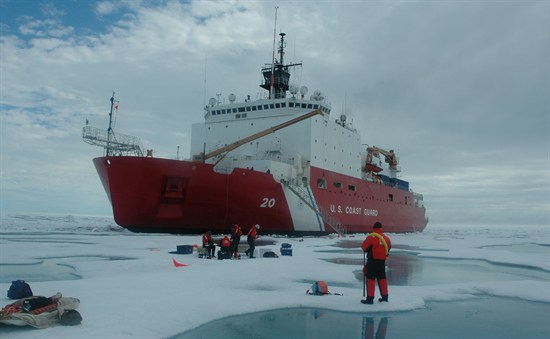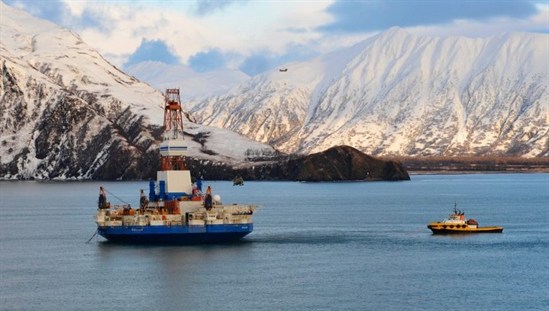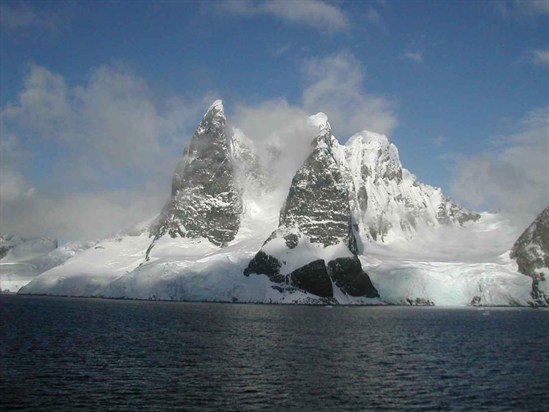If you want an indication that US ambition in the Arctic has been limited, you could turn to the size of its icebreaker fleet. Russia, which sees exploiting the Arctic as vital to its national interest, has 20 icebreakers. At present, America has just three.
To the frustration of many, the US has never placed the region near the top of its list of priorities. But with the Arctic sea ice in long term retreat, and new economic possibilities opening in the region, that mindset may now be changing.
Soft security
Retreating sea ice creates new possibilities for resource extraction, tourism and fishing in the Arctic, as well as the prospect of a new trade route between the Atlantic and Pacific.
Last year, the US Department of Defense published its Arctic Strategy, followed just recently by an implementation plan. It marks a new level of US ambition in the region – the newly-published document defines US aims for the region thus:
“[A] secure and stable region where US national interests are safeguarded, the US homeland is protected, and nations work cooperatively to address challenges”.
Highlighting international cooperation, environmental stewardship and joint attempts to research and understand this fast-changing region, the strategy reveals a softer attitude toward security in the Arctic. The range of approaches outlined include building international cooperation through shared scientific missions, and working with other militaries and the US coastguard to respond to emergencies such as shipping accidents and oil spills.
Christian le Mière, a senior fellow for naval forces and maritime security at the International Institute of Strategic Studies explains the strategy reflects a wider, less confrontational, attitude toward security in the region:
“The Arctic is a relatively low-risk environment from the security point of view. Disputes are few in number and most economic claims are spoken for. In fact, trends in the region have been positive in terms of diplomacy. The lack of a security architecture means such positive trends may not be embedded in the longer term.”

One of the US’s three icebreakers. Its ageing fleet faces an uncertain future and plans to build new icebreakers do not seem to be progressing (Source: USMil)
Changing relations
Relations between Arctic nations didn’t always seem so congenial. Commentators describe a clear divide between countries on the Arctic Council, the intergovernmental forum for Arctic states. On one side sit countries such as Norway and the US, which emphasise stewardship of the environment and a measured approach to economic development, at least for the time being. And on the other, Russia and Canada have a more immediate interest in their own regional sovereignty and access to the Arctic’s resources.
Glada Lahn, a senior research fellow on energy, environment and resources at Chatham House explains:
“Russia has the most obvious economic need for Arctic resources and there is interest in the greater autonomy that oil might bring Greenlanders. But compared with many governments facing choices over extractives investment in ecologically sensitive areas, Arctic states can afford not to rush. In rich democracies, risk weighs more heavily than opportunity – public scrutiny and tougher safety and environmental rules will simply make many Arctic oil and gas operations unprofitable.
“Look at Shell’s drilling programme in offshore Alaska – the mounting cost of lawsuits, regulation and the burden of inadequate infrastructure mean that Shell has pulled back for now.”

Shell’s Kulluck drill rig in Alaska, being towed to safety after it was grounded in January 2013 (Source: US Coastguard)
In 2007, a Russian delegation of scientists and legislators caused widespread consternation by planting the national flag on the seafloor below the Arctic ice – a move Russia said strengthened its claim to nearly half the Arctic seabed. Some commentators were almost begging the US to step in before control of the region was wrested from it by more aggressive parties such as Russia and Canada – both of whom see the Arctic as a vital source of new resources.
Yet, there appears to have been a shift in relations. As Arctic expert Scott Borgerson wrote in Foreign Affairs, “a funny thing happened on the way to Arctic anarchy. […] A shared interest in profit has trumped the instinct to compete over territory”.
Even Russia’s prized northern naval fleet is receiving less funding than it used to, signalling that the country no longer sees America and the Nato countries as the threats it once did.
Potential territorial disputes have been defused through agreements such as the ilulissat Declaration, which requires nations with Arctic coasts to resolve claims peacefully. Meanwhile the UN Convention on the Law of the Sea, though never ratified by the US, has provided the template for settling maritime boundary arguments. The Arctic Council and its more secretive security counterpart, the Arctic Security Forces Roundtable, have found new relevance as the forums for negotiation and cooperation in the region.
Economic pragmatism and climate diplomacy
Such actions help illustrate the atmosphere of pragmatism in relations between Arctic nations. Despite playing to their respective domestic audiences with stirring rhetoric and grand gestures – including Russia’s unexpectedly harsh treatment of Greenpeace protesters last year – both Canada and Russia depend on cooperation from others to allow them to exploit the potential resources available. Duncan Depledge, research analyst on environment and security at the Royal United Services Institute says:
“Russia needs international cooperation – such as investment from Asia and technology from Europe and North America – if it’s going to exploit its Arctic resources. And every country needs the help of others when it comes to cleaning up transboundary environmental threats like oil spills or conducting search and rescue missions.”
The Arctic strategy also offers the US an opportunity to craft its image beyond Arctic relations. Secretary of State John Kerry sees America’s stint at the head of the Arctic Council, starting next year, as an opportunity to showcase the country’s commitment to tackling climate change – both in the Arctic and on the international stage.
In contrast to the current chair Canada, which strongly emphasises economic development in the region, Kerry has vowed to make climate change the priority – a move that reflects his desire to lead on reaching an internationally binding agreement on greenhouse gas emissions reduction at negotiations next year.
The US military’s softer security stance complements Kerry’s intentions. The US Arctic strategy outlines possible roles for military diplomacy such as working with other nations to monitor ice loss, map the region and support sustainable economic activity. Even activities like supporting civil transport and boosting infrastructure are expressed with an eye to promoting sustainability.

National interest
But while there is great emphasis on international sharing and caring, the plan is fundamentally geared toward the US national interest.
This ranges from uncontroversial concepts such as increasing telecommunications infrastructure, to more contested principles. An important part of the strategy involves ensuring the freedom of the seas – an old doctrine designed to allow access to the high seas for merchant vessels. The new document shows the military sees that preserving this right is of national interest to the US.
It is also ready to “challenge excessive maritime claims” from other Arctic nations. Future tensions may indeed arise if maritime traffic increases. For instance while Canada sees the northwest passage off its coast as its sovereign territory, the US has other ideas.
Soft security, blurred roles
The Arctic has become a place where preconceived notions and roles are challenged. Despite diplomatic deadlock on many other issues in international politics, Arctic nations manage to coexist relatively harmoniously – at least for the moment.
The US military’s future role in the Arctic looks set to be more fluid, mixing diplomacy with support for development and stewardship. It has also emerged as a key actor in America’s climate policy in the region, deeply involved with the practical aspects of responding to the Arctic’s fast-changing climate.
America’s strategy currently appears reflect the wider, more conciliatory, tone of Arctic relations. As the country is gears up to take a greater leadership role in the region, this state of affairs suggests it won’t encounter the degree of opposition it might have just a few years ago.
But without a formal security framework, that could change. More countries are flocking to stake their claim in the region. China is the latest country to gain observer status on the Arctic Council, while Norway’s depleting oil stocks could force it to reassess its own priorities when it comes to stewardship over economic development.
As the ice melts, and the balance of power and priorities shifts in the region, the US may have to work hard to assert its soft security approach.

